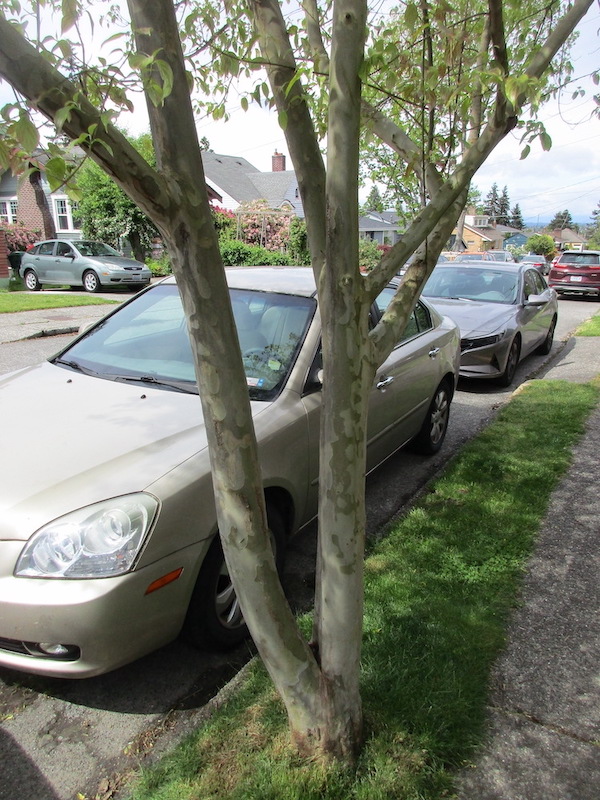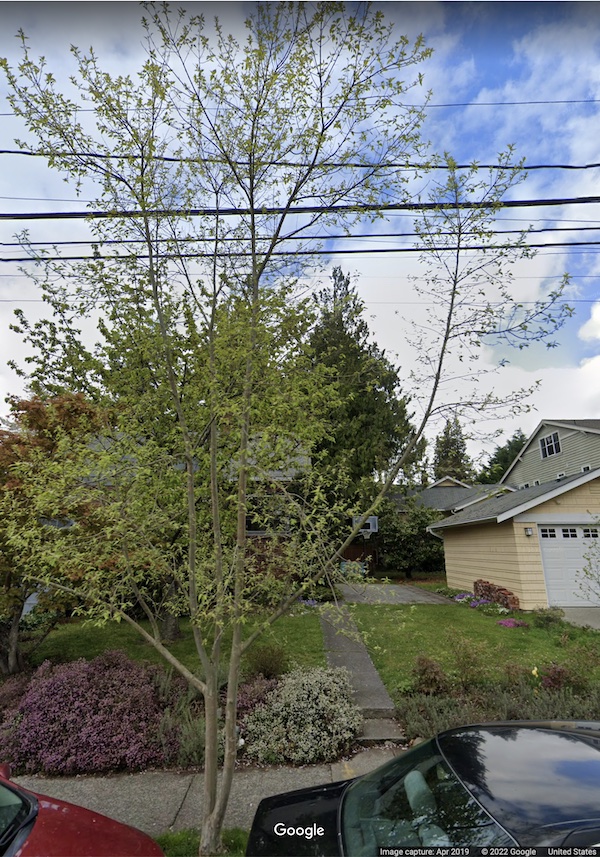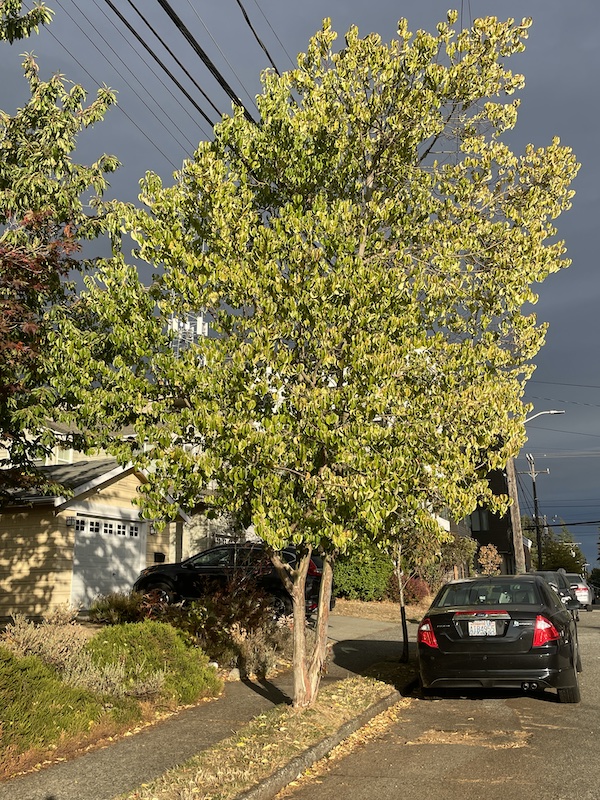Plant of the Month: June 2022
|
| Ghost Dogwood |
| Cornus Wilsoniana Wang. 1908 |
| = Cornus Fordii Hemsl. 1909 |
| = Cornus kweichowensis H.H. Li 1944 |
| = Swida Wilsoniana (Wang.) Soják 1960 |
CORNACEÆ; Dogwood Family
|
| The Ghost Dogwood, a Chinese tree known to Western science since 1887, remains undeservedly rare and little known in the USA. I found a specimen in Seattle in late May, became excited at the discovery, and am now sharing all I have learned about the special tree. It is a rare day when I stumble upon a tree wholly unknown to me. |
| In the 1990s, while writing my book North American Landscape Trees, I searched historic nursery catalogs of wholesale tree nurseries that provided trees in North America, but did not find this species. Therefore, it seems to have been distributed otherwise --and sparingly. Famous plantsman Ernest Wilson had seen the species in China (the tree was named after him), where it is distributed widely, and admired it, so promoted its planting in the USA in a lecture he delivered in November 1911. A specimen in New York was 3 or 4 feet tall by 1915. A tree --possibly the same-- flowered in Rochester July 2nd 1917. |
| According to Ray Larson, in 1995, Seattle's Washington Park Arboretum obtained seeds from Shanghai Botanic Garden (who got their seed from Mt. Heng in Hunan Province), and raised a tree that was planted in 1998. It grew in a shady area, was narrow, was more or less evergreen, and reached around 30 feet high. At one point its trunk was wounded significantly. It declined and was described as "poor" in 2015, and then died in the big freeze of early February 2019. Yet before it died, Far Reaches Farm nursery obtained cuttings and raised some to sell. Mike Lee infomed me that Colvos Creek nursery tried unsuccessfully to propagate the tree. Fortunately, the Washington Park Arboretum's Pat Calvert greenhouse rooted a cutting, so currently a small plant exists in its container nursery. |
| Cistus Nursery of Oregon has also sold plants in the past. Heronswood nursery never listed it. Forest Farm nursery of Oregon listed it from 2002 til at least 2007. The catalog description: "This red-barked dogwood tree (to 30 feet tall) has the showy bark and 2 - 3 inch clusters of small white summer flowers of its smaller but much appreciated relative, the red-twigged dogwood shrub." This description makes me wonder whether Forest Farm, actually sold another species under the Cornus Wilsoniana name. |
| The cultivar 'White Jade' was named in 2020 at the J.C. Raulston Arboretum in North Carolina, based on its exceptionally pretty bark. |
| The street-tree I found in Seattle's Mapleleaf neighborhood at 842 NE 89th Street, has an origin, of course. But I do not know it. It is planted underneath electrical wires, and has been pruned at its top. Google's street view image from April 2019 shows it had not yet been topped. When it makes flowers in late June or July I shall try to get pictures to post here. If it sets berries I will collect some so seedlings may be raised. It did not bloom; it has some fall color in late October as you can see from the photo below. |
| The species, in Chinese forests in Karst regions, varies from a shrub some 16 feet tall, to a tree 60 or even 130 feet high. It is described as deciduous but likely some more southerly populations can be tardily so, or even sub-evergreen. The same phenomenon occurs with N America's Cornus florida. The leaves are described as measuring up to 4.75 by 2.25 inches wide, dark green above, pale underneath. I have not read that the leaves can develop attractive fall color. White flowers about a third of an inch wide occur in crowded clusters 2.5 to 4 inches wide, and give rise to berries that are purplish-black, bluish-black, or black, a quarter inch or slightly larger. The remarkable thing about the tree's appearance is not its foliage, starry little blossoms, or berries, but its trunk. Joyfully, the bark is pale, smooth and peely, like a snow gum eucalypt. |
| In China, a name 光皮梾木 (Guang pi lai mu / Guang pi shu / Kuang p'i shu) translates "Smooth-bark tree." An edible, healthy cooking oil is extracted from its fruits (33 - 36% oil). The oil is rich in unsaturated fatty acids that decrease total cholesterol (TC), total triacylglycerol (TG), and low-density lipoprotein cholesterol (HDL-C). Aside from human dietary health application, the oil is used as a renewable biofuel crop to make a diesel substitute. Cultivars exist, higher in oil content. Plantations of the tree occur. |
| The tree is classified variously in Cornus subgenus Kraniopsis or Thelycrania. Five of its close cousin American species, all shrubby and lacking spectacular bark, are Cornus asperifolia (Eastern Roughleaf Dogwood), C. Drummondii (Roughleaf Dogwood), C. foemina (Stiff Dogwood), C. racemosa (Gray or Panicled Dogwood), and C. rugosa (Roundleaf Dogwood). |
| It is reported that in China, propagating the tree is difficult from cuttings, and seedlings show wide variation. So tissue culture is being tried. |
Wilson's Dogwood tree is certainly ornamental, cold-hardy to USDA zone 5, and should be grown more. I am curious about how much summer moisture it needs to thrive, because Seattle has drier summers than where the tree grows in China. Though at this writing, Seattle has been experiencing abnormally low temperatures and high humidity. All manner of trees and shrubs here are growing exuberantly as a result.
Back |

Seattle Cornus Wilsoniana May 2022 ; photo by ALJ
|

Seattle Cornus Wilsoniana April 2019 ; photo by Google street-view
|

Seattle Cornus Wilsoniana October 28 2022 ; photo by David Sucher
|
|
|

